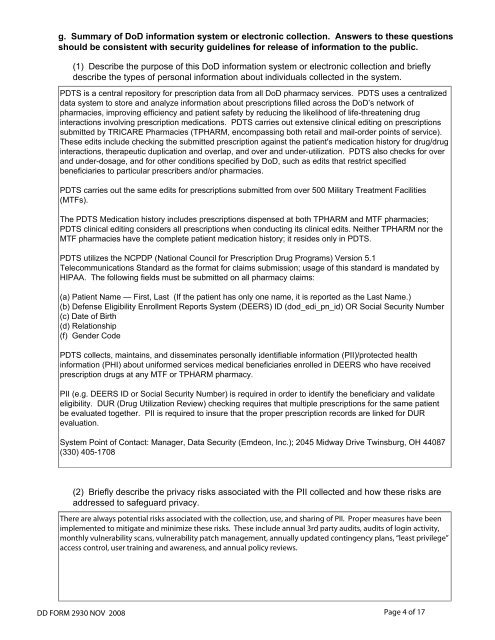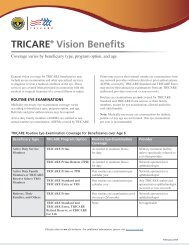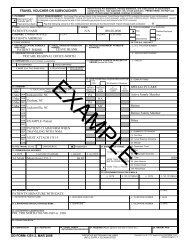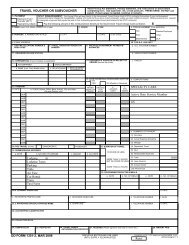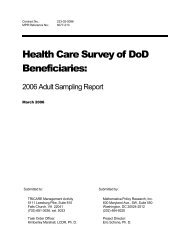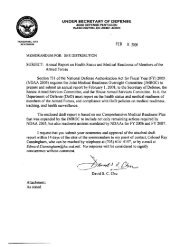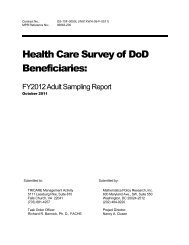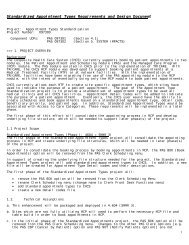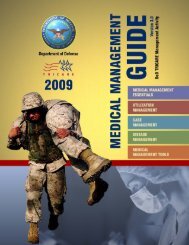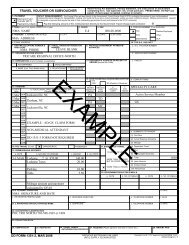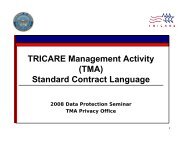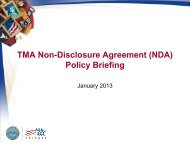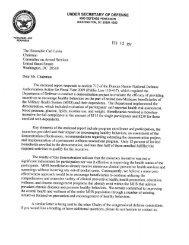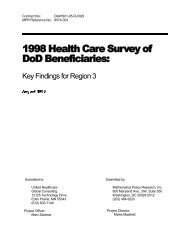Pharmacy Data Transaction Service (PDTS) - Tricare
Pharmacy Data Transaction Service (PDTS) - Tricare
Pharmacy Data Transaction Service (PDTS) - Tricare
Create successful ePaper yourself
Turn your PDF publications into a flip-book with our unique Google optimized e-Paper software.
g. Summary of DoD information system or electronic collection. Answers to these questions<br />
should be consistent with security guidelines for release of information to the public.<br />
(1) Describe the purpose of this DoD information system or electronic collection and briefly<br />
describe the types of personal information about individuals collected in the system.<br />
<strong>PDTS</strong> is a central repository for prescription data from all DoD pharmacy services. <strong>PDTS</strong> uses a centralized<br />
data system to store and analyze information about prescriptions filled across the DoD’s network of<br />
pharmacies, improving efficiency and patient safety by reducing the likelihood of life-threatening drug<br />
interactions involving prescription medications. <strong>PDTS</strong> carries out extensive clinical editing on prescriptions<br />
submitted by TRICARE Pharmacies (TPHARM, encompassing both retail and mail-order points of service).<br />
These edits include checking the submitted prescription against the patient's medication history for drug/drug<br />
interactions, therapeutic duplication and overlap, and over and under-utilization. <strong>PDTS</strong> also checks for over<br />
and under-dosage, and for other conditions specified by DoD, such as edits that restrict specified<br />
beneficiaries to particular prescribers and/or pharmacies.<br />
<strong>PDTS</strong> carries out the same edits for prescriptions submitted from over 500 Military Treatment Facilities<br />
(MTFs).<br />
The <strong>PDTS</strong> Medication history includes prescriptions dispensed at both TPHARM and MTF pharmacies;<br />
<strong>PDTS</strong> clinical editing considers all prescriptions when conducting its clinical edits. Neither TPHARM nor the<br />
MTF pharmacies have the complete patient medication history; it resides only in <strong>PDTS</strong>.<br />
<strong>PDTS</strong> utilizes the NCPDP (National Council for Prescription Drug Programs) Version 5.1<br />
Telecommunications Standard as the format for claims submission; usage of this standard is mandated by<br />
HIPAA. The following fields must be submitted on all pharmacy claims:<br />
(a) Patient Name — First, Last (If the patient has only one name, it is reported as the Last Name.)<br />
(b) Defense Eligibility Enrollment Reports System (DEERS) ID (dod_edi_pn_id) OR Social Security Number<br />
(c) Date of Birth<br />
(d) Relationship<br />
(f) Gender Code<br />
<strong>PDTS</strong> collects, maintains, and disseminates personally identifiable information (PII)/protected health<br />
information (PHI) about uniformed services medical beneficiaries enrolled in DEERS who have received<br />
prescription drugs at any MTF or TPHARM pharmacy.<br />
PII (e.g. DEERS ID or Social Security Number) is required in order to identify the beneficiary and validate<br />
eligibility. DUR (Drug Utilization Review) checking requires that multiple prescriptions for the same patient<br />
be evaluated together. PII is required to insure that the proper prescription records are linked for DUR<br />
evaluation.<br />
System Point of Contact: Manager, <strong>Data</strong> Security (Emdeon, Inc.); 2045 Midway Drive Twinsburg, OH 44087<br />
(330) 405-1708<br />
(2) Briefly describe the privacy risks associated with the PII collected and how these risks are<br />
addressed to safeguard privacy.<br />
There are always potential risks associated with the collection, use, and sharing of PII. Proper measures have been<br />
implemented to mitigate and minimize these risks. These include annual 3rd party audits, audits of login activity,<br />
monthly vulnerability scans, vulnerability patch management, annually updated contingency plans, “least privilege”<br />
access control, user training and awareness, and annual policy reviews.<br />
DD FORM 2930 NOV 2008 Page 4 of 17


